Please fill out the following information, and RRFC Admissions will contact you to discuss our program offerings:
Issue #172
by L. Swift and Jeff McQ
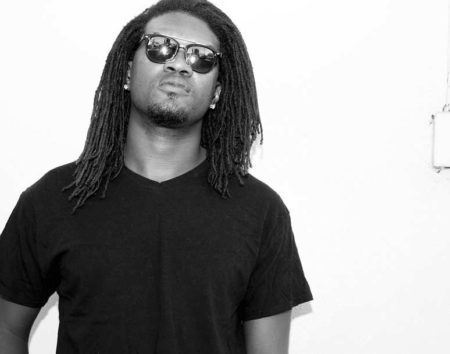 Hard work and a willingness to diversify have taken Recording Connection grad Jamaal Taylor a long way. Working in Hollywood as a DJ tech and sound engineer for the prestigious Avalon Hollywood (at the historic corner of Hollywood and Vine), the dynamic composer/producer recently landed placement for two songs in the film Sleight, a genre-bending flick that recently scored high marks in its theatrical release!
The songs that made the soundtrack are named “Stick Up” and “S.O.G.”. Both tracks are co-written by Jamaal and hip-hop artist and lifelong friend AmirSaysNothing. Jamaal says his ability to create beats from scratch had a lot to do with getting it placed.
“The guy who was the music supervisor of Sleight hit up Amir and was like, ‘Hey, I need some hip hop for this movie that we’re working on, and this song literally fits perfectly in it.’ …When they found out that I didn’t use any samples and I made everything from scratch, that was when they sort of freaked out and were like, ‘Yes, we want this in the movie because we don’t have do clear anything.’”
Growing up in New York, Jamaal says his interest in music started with making beats using GarageBand as a teenager, and it eventually took over his passions as a college student. “I went to Wesleyan University,” he says, “but it ended up being too expensive and I had to drop out because I couldn’t afford it. But even while I was in school, I would stay up all night making beats on Garage Band, and a lot of my friends were creative people too, and we were recording ourselves…I ended up realizing that I wanted to do music more than I wanted to study and become a lawyer or doctor or something like that.”
A trip to visit his mom in Los Angeles turned into a permanent move, he says. Three months later, he discovered the Recording Connection. “I was like, ‘This looks more like what I’m aligned with,’ like having an externship, because I had already been to college,” he says. “I was kind of over the whole college atmosphere and just that way of learning…It was definitely a good idea.”
Jamaal soon found himself apprenticing at Angel House Studios with Recording Connection mentor Drew Kapner—a relationship that has continued long since. “Our personalities meshed really well,” says Jamaal. “I still consider him a friend today. We still work together…He’ll hit me up if he knows that I’m the right person for a certain project.”
For Jamaal Taylor aka Cy Kosis, who went into the program to learn music production as an electronic musician, he says the experience working with Drew in the studio gave him a broader perspective as to how to work in the industry in general.
“I needed some sort of direction because there are so many different directions to go in, in the music industry,” he says. I needed to have someone be like, ‘This is what you should do, this is what you’re good at, this is what you’re not good at, this is what you need to work on.’ I think learning how to be a better music producer helped inform the decisions that I make now.”
Jamaal also says Drew went the extra mile to help him learn the engineering skills he needed to hone his craft as an electronic musician. “When I was first learning just about engineering in the first place, one of the hardest things for me to understand was what compression was and how compression worked,” he says. ‘[Drew] veered off the curriculum and was just like, ‘Okay, I can understand, since you’re an electronic music artist, you really need to understand what compression is.’ And he just spent a really long time with me making sure that I really, really got it… He spent maybe a good month just explaining to me the details of compression.”
Yet another thing Jamaal says he learned from Drew was the importance of being diverse as a music professional without getting pigeonholed into just one thing. “He was like, ‘You can’t just be a music producer, you can’t just be a DJ, you can’t just be an engineer…In order to be successful in this industry you have to not focus only on getting good at one thing.’ That was a lesson that I clearly took seriously.”
Today, Jamaal does take that advice seriously, working on multiple income streams to make a living in music. While the DJ tech and sound engineer job at Avalon serves him well, he also works on landing production deals and placements, including the recent tracks on the film.
Sleight, an indie sci-fi/fantasy/suspense film from the producer of surprise hit Get Out, is now showing nationally in theaters across the country. Go see it if you have the chance. Congrats to Jamaal Taylor on his achievements!
Hard work and a willingness to diversify have taken Recording Connection grad Jamaal Taylor a long way. Working in Hollywood as a DJ tech and sound engineer for the prestigious Avalon Hollywood (at the historic corner of Hollywood and Vine), the dynamic composer/producer recently landed placement for two songs in the film Sleight, a genre-bending flick that recently scored high marks in its theatrical release!
The songs that made the soundtrack are named “Stick Up” and “S.O.G.”. Both tracks are co-written by Jamaal and hip-hop artist and lifelong friend AmirSaysNothing. Jamaal says his ability to create beats from scratch had a lot to do with getting it placed.
“The guy who was the music supervisor of Sleight hit up Amir and was like, ‘Hey, I need some hip hop for this movie that we’re working on, and this song literally fits perfectly in it.’ …When they found out that I didn’t use any samples and I made everything from scratch, that was when they sort of freaked out and were like, ‘Yes, we want this in the movie because we don’t have do clear anything.’”
Growing up in New York, Jamaal says his interest in music started with making beats using GarageBand as a teenager, and it eventually took over his passions as a college student. “I went to Wesleyan University,” he says, “but it ended up being too expensive and I had to drop out because I couldn’t afford it. But even while I was in school, I would stay up all night making beats on Garage Band, and a lot of my friends were creative people too, and we were recording ourselves…I ended up realizing that I wanted to do music more than I wanted to study and become a lawyer or doctor or something like that.”
A trip to visit his mom in Los Angeles turned into a permanent move, he says. Three months later, he discovered the Recording Connection. “I was like, ‘This looks more like what I’m aligned with,’ like having an externship, because I had already been to college,” he says. “I was kind of over the whole college atmosphere and just that way of learning…It was definitely a good idea.”
Jamaal soon found himself apprenticing at Angel House Studios with Recording Connection mentor Drew Kapner—a relationship that has continued long since. “Our personalities meshed really well,” says Jamaal. “I still consider him a friend today. We still work together…He’ll hit me up if he knows that I’m the right person for a certain project.”
For Jamaal Taylor aka Cy Kosis, who went into the program to learn music production as an electronic musician, he says the experience working with Drew in the studio gave him a broader perspective as to how to work in the industry in general.
“I needed some sort of direction because there are so many different directions to go in, in the music industry,” he says. I needed to have someone be like, ‘This is what you should do, this is what you’re good at, this is what you’re not good at, this is what you need to work on.’ I think learning how to be a better music producer helped inform the decisions that I make now.”
Jamaal also says Drew went the extra mile to help him learn the engineering skills he needed to hone his craft as an electronic musician. “When I was first learning just about engineering in the first place, one of the hardest things for me to understand was what compression was and how compression worked,” he says. ‘[Drew] veered off the curriculum and was just like, ‘Okay, I can understand, since you’re an electronic music artist, you really need to understand what compression is.’ And he just spent a really long time with me making sure that I really, really got it… He spent maybe a good month just explaining to me the details of compression.”
Yet another thing Jamaal says he learned from Drew was the importance of being diverse as a music professional without getting pigeonholed into just one thing. “He was like, ‘You can’t just be a music producer, you can’t just be a DJ, you can’t just be an engineer…In order to be successful in this industry you have to not focus only on getting good at one thing.’ That was a lesson that I clearly took seriously.”
Today, Jamaal does take that advice seriously, working on multiple income streams to make a living in music. While the DJ tech and sound engineer job at Avalon serves him well, he also works on landing production deals and placements, including the recent tracks on the film.
Sleight, an indie sci-fi/fantasy/suspense film from the producer of surprise hit Get Out, is now showing nationally in theaters across the country. Go see it if you have the chance. Congrats to Jamaal Taylor on his achievements!
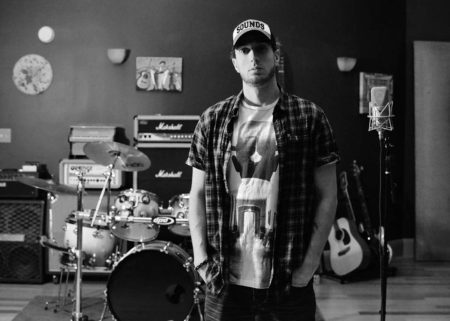 We’re always happy when Recording Connection mentor Sean Giovanni finds some time to talk with us! A music industry veteran in Nashville, not only has Sean worked with major players like Tim McGraw and John Legend, but he also hosts a local show called BalconyTV which features live performances from up-and-coming Nashville talent.
Sean recently had the opportunity to move his Nashville recording studio, The Record Shop, into a much larger, more versatile space. He was excited to talk with us about it and share the possible benefits to Recording Connection students, as well. During the conversation, he also shared some detailed tips on how he likes to mike live drums, which many of our audio students should find very helpful! Enjoy!
We’re always happy when Recording Connection mentor Sean Giovanni finds some time to talk with us! A music industry veteran in Nashville, not only has Sean worked with major players like Tim McGraw and John Legend, but he also hosts a local show called BalconyTV which features live performances from up-and-coming Nashville talent.
Sean recently had the opportunity to move his Nashville recording studio, The Record Shop, into a much larger, more versatile space. He was excited to talk with us about it and share the possible benefits to Recording Connection students, as well. During the conversation, he also shared some detailed tips on how he likes to mike live drums, which many of our audio students should find very helpful! Enjoy!
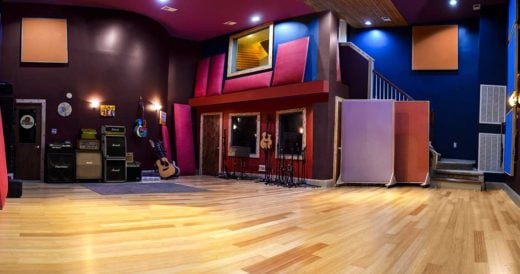
Live Room in The Record Shop
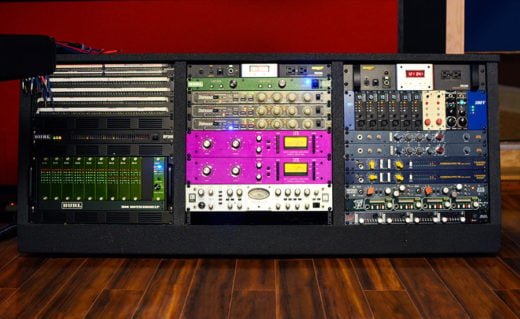 RRFC: Anything else you want to tell us about your new space?
Sean: One other thing that I think is pretty cool that I’m excited to share with our students is we’ve set up a secondary production room that during the time will be utilized for mixing, editing, and basic overdubs as well as vocal recording. So while I’m working on maybe one of our major projects in one room, we can be doing background vocals or overdubs or editing or programming in the other room. The B room is set up with an identical Pro Tools HD system and has the same plugins and software that I have on my main computer, which allows us to send sessions back and forth, and has access to the same incredible mike closet that we have at the studio. So any clients that come in and may just want to cut a vocal, they have access to all the same microphones that they would if they were booking our main room…But how I think that room will have the biggest effect on what we offer to the Recording Connection program is that our students will be able to have an identical system to the system that I work on to be able to practice on while we’re in sessions. So as opposed just coming in on their non-lesson days…they’ll be able to simultaneously work on the same session that I’m working on in the other room, and we’ll be able to review that and give them more direct, hands-on experience throughout the program.
RRFC: Anything else you want to tell us about your new space?
Sean: One other thing that I think is pretty cool that I’m excited to share with our students is we’ve set up a secondary production room that during the time will be utilized for mixing, editing, and basic overdubs as well as vocal recording. So while I’m working on maybe one of our major projects in one room, we can be doing background vocals or overdubs or editing or programming in the other room. The B room is set up with an identical Pro Tools HD system and has the same plugins and software that I have on my main computer, which allows us to send sessions back and forth, and has access to the same incredible mike closet that we have at the studio. So any clients that come in and may just want to cut a vocal, they have access to all the same microphones that they would if they were booking our main room…But how I think that room will have the biggest effect on what we offer to the Recording Connection program is that our students will be able to have an identical system to the system that I work on to be able to practice on while we’re in sessions. So as opposed just coming in on their non-lesson days…they’ll be able to simultaneously work on the same session that I’m working on in the other room, and we’ll be able to review that and give them more direct, hands-on experience throughout the program.
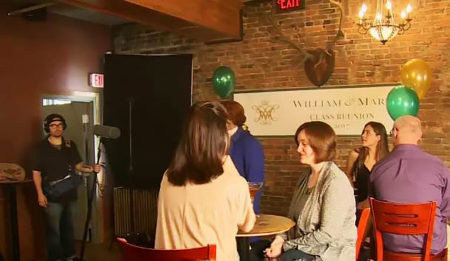 Film Connection student Jessica Wise (Lexington, KY) got to learn firsthand that you never know what might happen on a film set! “I got to be an extra in the commercial! Shooting took place in a popular bar in downtown Lexington…This was my first time seeing a professional make-up artist and costume designer on a set. They took great care making the actors and extras look presentable on screen and were always on stand-by in case anyone ever needed a touch up. I hadn’t planned on being an extra when I showed up that day – it was sprung upon me!…I even appeared on local TV! A local news station came by to film a piece on the shoot and I made it in their segment! Check me out – I’m the girl in the middle in the tan shirt, back to the camera with long dark hair.”
Film Connection student Jessica Wise (Lexington, KY) got to learn firsthand that you never know what might happen on a film set! “I got to be an extra in the commercial! Shooting took place in a popular bar in downtown Lexington…This was my first time seeing a professional make-up artist and costume designer on a set. They took great care making the actors and extras look presentable on screen and were always on stand-by in case anyone ever needed a touch up. I hadn’t planned on being an extra when I showed up that day – it was sprung upon me!…I even appeared on local TV! A local news station came by to film a piece on the shoot and I made it in their segment! Check me out – I’m the girl in the middle in the tan shirt, back to the camera with long dark hair.”
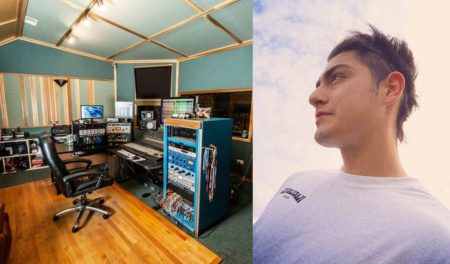 Recording Connection student Alejandro Espinoza (Chicago, IL ) is improving his skills quickly, thanks to the expert guidance he’s getting. “It’s been over 3 months with The Recording Connection and I can honestly say it is exactly how I pictured it. Working one on one with Mike Petro from Chicago’s very own Miller Street Studios has been a very exciting and very educational part of the program. Learning from a professional has given me the correct insight to target the hardest parts of the Production part of the program and I feel very satisfied as well as confident with the changes I’ve made with my own projects as well as those worked on with Mike. Always excited for the next session.”
Recording Connection student Alejandro Espinoza (Chicago, IL ) is improving his skills quickly, thanks to the expert guidance he’s getting. “It’s been over 3 months with The Recording Connection and I can honestly say it is exactly how I pictured it. Working one on one with Mike Petro from Chicago’s very own Miller Street Studios has been a very exciting and very educational part of the program. Learning from a professional has given me the correct insight to target the hardest parts of the Production part of the program and I feel very satisfied as well as confident with the changes I’ve made with my own projects as well as those worked on with Mike. Always excited for the next session.”

RRFC is education upgraded for the 21st century.
Get the latest career advice, insider production tips, and more!
Please fill out the following information, and RRFC Admissions will contact you to discuss our program offerings:
Stay in the Loop: Subscribe for RRFC news & updates!
© 2025 Recording Radio Film Connection & CASA Schools. All Rights Reserved.


